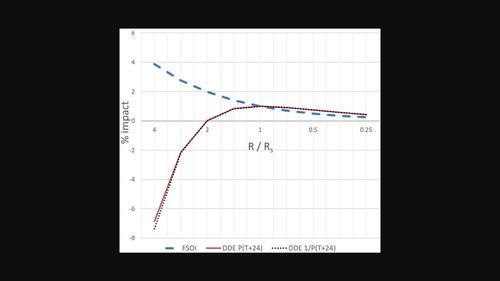Observation impact metrics in NWP: a theoretical study. Part II: systems with suboptimal observation errors
IF 2.9
3区 地球科学
Q2 METEOROLOGY & ATMOSPHERIC SCIENCES
引用次数: 1
Abstract
Abstract Two methods are widely used to assess the impact of observations in global numerical weather prediction (NWP): data denial experiments (DDEs) and the forecast sensitivity‐based observation impact (FSOI) method. A DDE measures the impact on forecast accuracy of removing an observation type from the system, whereas FSOI estimates the amount by which an observation type reduces the short‐range forecast error within a system containing all observation types. This paper describes the second part of a two‐part study. In the first part, the theory behind DDE and FSOI metrics was presented and then applied to a simple model with two state variables, all in the context of optimal data assimilation (DA), for which the error covariances used in the DA system match reality. The paper showed why and under what conditions the DDE and FSOI metrics give different results, even for an optimal DA system. In this second part, we extend the theory to suboptimal systems, and specifically to systems that are suboptimal in their specification of observation errors, and then apply it to a very simple model, in this case with one state variable. As expected, DDE impacts are reduced when the system is suboptimal. By contrast, relative FSOI impacts (i.e. relative to those of other observation types) increase for an observation type for which the errors are underestimated. This gives the erroneous impression that the change in assumed errors has led to an improvement, whereas the opposite is the case. These results provide some insights into the interpretation of FSOI results from a suboptimal DA system. This article is protected by copyright. All rights reserved.

NWP观测影响指标的理论研究。第二部分:具有次优观测误差的系统
在全球数值天气预报(NWP)中,广泛采用两种方法来评估观测影响:数据否认实验(DDEs)和基于预测灵敏度的观测影响(FSOI)方法。DDE衡量的是从系统中移除一种观测类型对预报精度的影响,而FSOI估计的是一种观测类型在包含所有观测类型的系统中减少短期预报误差的量。本文描述了两部分研究的第二部分。在第一部分中,介绍了DDE和FSOI度量背后的理论,然后将其应用于具有两个状态变量的简单模型,所有这些都是在最佳数据同化(DA)的背景下,DA系统中使用的误差协方差与实际相符。本文展示了为什么DDE和FSOI指标给出不同的结果,以及在什么条件下,即使是最优的数据处理系统。在第二部分中,我们将理论扩展到次优系统,特别是在观测误差规范方面的次优系统,然后将其应用到一个非常简单的模型中,在这种情况下只有一个状态变量。正如预期的那样,当系统处于次优状态时,DDE的影响会减少。相比之下,对于误差被低估的观测类型,相对FSOI影响(即相对于其他观测类型的影响)会增加。这给人一种错误的印象,即假定误差的变化导致了改进,而事实恰恰相反。这些结果为解释次优DA系统的FSOI结果提供了一些见解。这篇文章受版权保护。版权所有。
本文章由计算机程序翻译,如有差异,请以英文原文为准。
求助全文
约1分钟内获得全文
求助全文
来源期刊
CiteScore
16.80
自引率
4.50%
发文量
163
审稿时长
3-8 weeks
期刊介绍:
The Quarterly Journal of the Royal Meteorological Society is a journal published by the Royal Meteorological Society. It aims to communicate and document new research in the atmospheric sciences and related fields. The journal is considered one of the leading publications in meteorology worldwide. It accepts articles, comprehensive review articles, and comments on published papers. It is published eight times a year, with additional special issues.
The Quarterly Journal has a wide readership of scientists in the atmospheric and related fields. It is indexed and abstracted in various databases, including Advanced Polymers Abstracts, Agricultural Engineering Abstracts, CAB Abstracts, CABDirect, COMPENDEX, CSA Civil Engineering Abstracts, Earthquake Engineering Abstracts, Engineered Materials Abstracts, Science Citation Index, SCOPUS, Web of Science, and more.

 求助内容:
求助内容: 应助结果提醒方式:
应助结果提醒方式:


